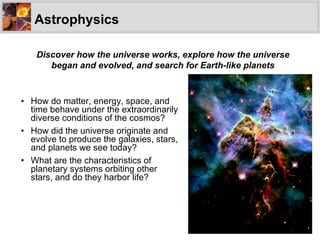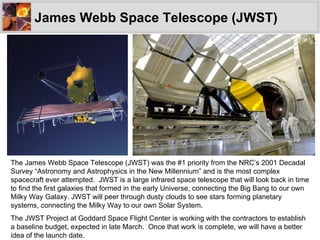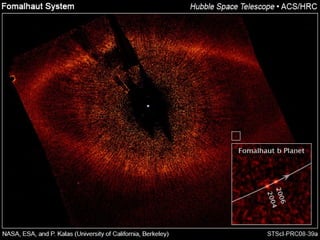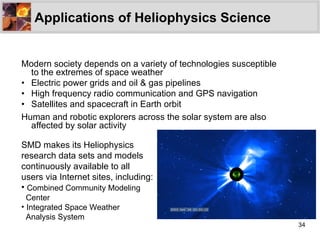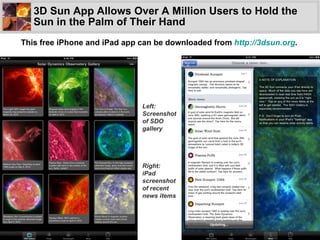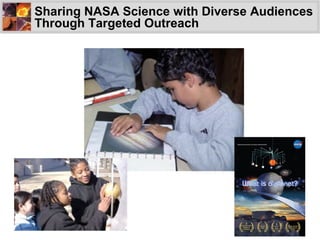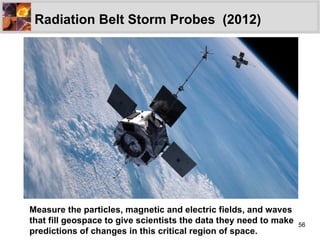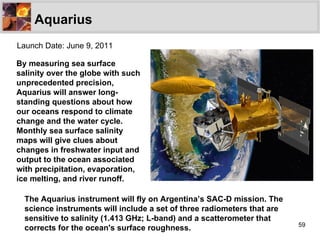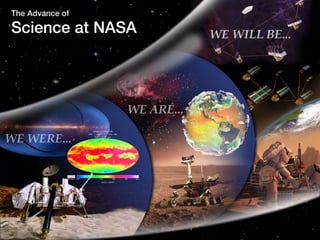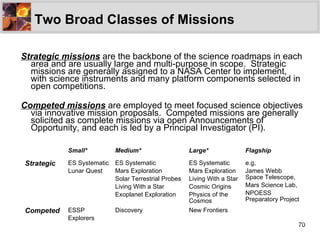Overview of NASA's Science Mission Directorate
- 1. NASA Science Science Mission Directorate Overview May 2011
- 2. NASA Science Answers science questions of compelling interest to all humanity. Extends our nation’s leadership in science while enabling partnerships that strengthen our international standing and relationships. Inspires and trains the next generation of scientists, engineers, educators and citizens. Provides information for use in response to national and international disasters. Develops new technologies that drive innovation and impact the economy. Provides objective research and observations to policy-makers and decision-makers in both the public and private sectors
- 3. Our Journey of Discovery NASA’s science program seeks answers to profound questions that touch or may affect us all: How and why are Earth’s climate and the environment changing? How and why does the Sun vary and affect Earth and the rest of the solar system? How do planets and life originate? How does the universe work, and what are its origin and destiny? Are we alone?
- 4. SMD At A Glance 98 spacecraft, 57 missions in operation, 28 more in development Plus aircraft, sounding rockets, balloons, and surface networks Over 94% of every dollar NASA receives goes out the door to universities, commercial entities, and not-for-profits More than 10,000 U.S. scientists funded by 3,000 competitively selected research awards Partnerships with a dozen Federal agencies and 60 other nations More than $500M of total SMD funds invested annually in technology development Global impact on humanity’s understanding of our place in the universe
- 5. SMD Principles Substantial progress on NRC decadal surveys in all four science areas is the measure of success Investment choices are based on scientific merit via peer review and open competition Active participation by the research community beyond NASA is critical to success Effective international and interagency partnerships leverage NASA resources and extend the reach of our science results A balanced portfolio of space missions and mission-enabling programs sustains progress toward NASA’s science goals The NASA mandate includes broad public communication Accountability, transparent processes, accessible results, and capture of lessons learned are essential features of this Federal science enterprise
- 6. Recommendations from the U.S. Scientific Community Through NRC Decadal Surveys Astrophysics 2010 (2020) Heliophysics 2003 (2012) Earth Science 2007 (2017) Planetary Science 2002 (2011)
- 7. Engaging the Next Generation SMD policy calls for each mission to allocate at least 1% of the mission budget for education and public outreach (E/PO activities SMD funds E/PO activities as elements proposed as part of competitively-selected research and research-enabling programs Each SMD Division has a Science Education and Public Outreach Forum (SEPOF) to help better connect NASA and the broad national education community SMD engages in collaborations with such organizations as: NASA Museum Alliance for science centers, museums, and planetariums Boys Scouts/Girl Scouts, 4-H clubs, and Boy’s and Girl’s Clubs of America SMD’s E/PO programs are coordinated with the NASA Office of Education To share the story, the science, and the adventure of NASA’s scientific explorations of our home planet, the solar system, and the universe beyond…
- 8. Science Metrics NASA’s had 8.4% of worldwide scientific discoveries in 2010 3.0% from extended mission (flagships launched in the 1990’s and 1970’s) 2.8% from non-mission science (astrobiology and other grants) 1.4% from extended missions (small/moderate sized, including series like POES) 1.3% from prime mission science Fermi was the most productive prime mission, with 1.1% of discoveries Space Science contributions at 7.0% NASA Earth Science had 1.4% of discoveries Astrobiology produced 1.7% of discoveries NASA’s non-mission science produces 2.8% of world-wide science
- 11. Astrophysics How do matter, energy, space, and time behave under the extraordinarily diverse conditions of the cosmos? How did the universe originate and evolve to produce the galaxies, stars, and planets we see today? What are the characteristics of planetary systems orbiting other stars, and do they harbor life? Discover how the universe works, explore how the universe began and evolved, and search for Earth-like planets Visible view of Pillar and Jets HH 901/902 from Hubble Space Telescope Credit: NASA, ESA, STScI
- 12. Astrophysics Missions in Operation
- 13. Stratospheric Observatory For Infrared Astronomy (SOFIA) First Science Flight December 1, 2010 In-Flight Mission Control Operations Open Door Flight December 18, 2009 Crew Members with FORCAST Instrument 1 st Flight (Aircraft Functional Checks) December 2009 1 st Open Door Flight December 2009 First Light Opportunity May 2010 Envelope Expansion #2 July 2010 Initiation of Science Flights with FORCAST (US-developed imager) December 2010 Science Flights with GREAT begin August 2011 Guest Observation Flights Begin October 2011 Commissioning of HIPO & FLITECAM begins February 2012 End of Development Segment 2; Start of Major System Upgrades June 2012 Commissioning of Fourth Instrument begins July 2013 Full Operational Capability (FOC) December 2014
- 14. James Webb Space Telescope (JWST) The James Webb Space Telescope (JWST) was the #1 priority from the NRC’s 2001 Decadal Survey “Astronomy and Astrophysics in the New Millennium” and is the most complex spacecraft ever attempted. JWST is a large infrared space telescope that will look back in time to find the first galaxies that formed in the early Universe, connecting the Big Bang to our own Milky Way Galaxy. JWST will peer through dusty clouds to see stars forming planetary systems, connecting the Milky Way to our own Solar System. The JWST Project at Goddard Space Flight Center is working with the contractors to establish a baseline budget, expected in late March. Once that work is complete, we will have a better idea of the launch date.
- 19. Omega Centauri (NGC 5139)
- 20. Hubble’s Deepest View of the Universe The Hubble Space Telescope has acquired the deepest image of the universe ever taken in near-infrared light using the newly installed Wide Field Camera 3. 2009 Infrared Ultra Deep Field
- 21. Title Goes Here
- 22. Planetary Science What is the inventory of solar system objects and what processes are active in and among them? How did the Sun’s family of planets, satellites, and minor bodies originate and evolve? What are the characteristics of the solar system that lead to habitable environments? How and where could life begin and evolve in the solar system? What are characteristics of small bodies and planetary environments that pose hazards and/or provide resources? Ascertain the content, origin, and evolution of the solar system and the potential for life elsewhere Victoria Crater from the Mars Reconnaissance Orbiter, July 18, 2009 Credit: NASA/JPL-Caltech/University of Arizona
- 23. Planetary Science Missions in Operation
- 24. Hale Crater showing gullies on side of crater wall. Crater is approximately 149km across, located in Argyre basin, 38.8 o S, 36.5 o W Gullies on Mars: Are the Flow Features from Water?
- 25. Martian Ice Found Just Below the Surface Fresh small impact craters show: Ice layer ~0.5 – 1m below surface Sublimates over several weeks Spectral analysis shows ~99% pure water Ice more extensive than expected from current climate Mars had a wet history 35m 88 days 50 days 43.3° N 164.2° E 46.2° N 188.5° E
- 26. Life in Extreme Environments: Yellowstone N.P.
- 27. The Icy Surface of Europa
- 28. Water Vapor in Geyser-like Jets on Saturn’s Moon Enceladus
- 29. Upcoming Significant Events Launches in 2011: Juno (August 5) - Juno will investigate Jupiter’s interior structure, deep atmosphere and magnetosphere, measure the abundance of oxygen on the planet, and monitor localized variations in concentrations of water and ammonia caused by meteorological factors. Juno will also investigate the convection that drives general circulation patterns in Jupiter’s atmosphere. GRAIL (September 8) – GRAIL’s two satellites will fly in tandem to map the gravity field of the Moon to determine the structure of the lunar interior, from crust to core, and to advance understanding of the thermal evolution of the Moon. GRAIL is based on the GRACE mission, which has been studying the Earth’s gravity field since 2002. MSL (November 25) Mission Milestones in 2011: Stardust-NExT (February 14) – The mission will encounter Comet Tempel 1 and make observations of the comet’s dust properties. The encounter will provide a comparison of two comets (Tempel 1 and Wild 2) by the same instrument and multiple observations of Tempel 1 before and after a pass around the Sun MESSENGER (March 18) – MESSENGER will begin the process of orbit insertion around Mercury, becoming the first spacecraft to ever orbit the planet. Once in orbit, MESSENGER will determine Mercury's composition, image its surface, map its magnetic field and measure the properties of its core, explore the mysterious polar deposits to learn whether ice lurks in permanently shadowed regions, and characterize Mercury's tenuous atmosphere and Earth-like magnetosphere. Dawn (August) – Dawn will begin it’s one year orbit of the asteroid Vesta.
- 30. Mars Rover Family Portrait MSL “Curiosity” is the largest rover yet…to assess whether Mars ever was, or is still today, an environment able to support microbial life. In other words, its mission is to determine the planet's "habitability. Spirit and Opportunity 2003 Sojourner 1996 Curiosity 2011
- 31. Mars Science Laboratory SAM Installation Assembled Spacecraft Descent Stage Rover Driving Test
- 33. Heliophysics What causes the Sun to vary? How do the Earth and the heliosphere respond? What are the impacts on humanity? Understand the Sun and its interactions with the Earth and the solar system First light SDO image from March 30, 2010 Credit: NASA/GSFC/AIA
- 34. Applications of Heliophysics Science Modern society depends on a variety of technologies susceptible to the extremes of space weather Electric power grids and oil & gas pipelines High frequency radio communication and GPS navigation Satellites and spacecraft in Earth orbit Human and robotic explorers across the solar system are also affected by solar activity SMD makes its Heliophysics research data sets and models continuously available to all users via Internet sites, including: Combined Community Modeling Center Integrated Space Weather Analysis System STEREO Views a Solar Storm in October 2009
- 35. Heliophysics Missions in Operation
- 38. 3D Sun App Allows Over A Million Users to Hold the Sun in the Palm of Their Hand This free iPhone and iPad app can be downloaded from http://3dsun.org . Left: Screenshot of SDO gallery Right: iPad screenshot of recent news items
- 40. Earth Science How is the global Earth system changing? (Characterize) What are the sources of change in the Earth system and their magnitudes and trends? (Understand) How will the Earth system change in the future? (Predict) How can Earth System Science improve mitigation of and adaptation to global change? (Apply) Advance Earth System Science to meet the challenges of climate and environmental change Terra satellite image of plume from the Iceland volcano in April 2010 An end-to-end program encompassing space missions, suborbital platforms, data and information systems, fundamental research, data assimilation and modeling, applications research, and technology development.
- 41. Earth Science Research and Applications Applications Themes: Agriculture Air Quality Climate Ecological Forecasting Public Health Natural Disasters Water Resources Weather Science Focus Areas: Atmospheric Composition Carbon Cycle & Ecosystems Climate Variability & Change Weather Water & Energy Cycle Earth Surface & Interior Observed trends in groundwater levels from GRACE October 2003 – March 2009
- 42. Earth Science Missions in Operation
- 44. Hurricane Danielle’s Hot Towers from TRMM August 27, 2010
- 45. April 7, 2001 April 11, 2001 April 13, 2001 April 16, 2001 China Dust Storm Pollutes the Air in the Eastern US in April 2001
- 46. Response to Gulf Oil Spill Satellite instruments: continually monitored the extent of the spill Terra & Aqua / MODIS – visible and infrared daily synoptic Terra / ASTER – visible, near IR and thermal IR high res EO-1 / Advanced Land Imager and Hyperion – highest res Terra / MISR CALIPSO / CALIOP Airborne instruments: measured surface extent and volume ER2 / AVIRIS and DCS, MASTER – May, Jul, Aug, Sept Twin Otter / AVIRIS (July 1-12) B200 / HSRL– 10-11 May; two FOO; CALIOP studies UAVSAR– 22-24 June Data and provided to USGS for use by first responders; NOAA using radiances to initialize trajectory model, USGS for oil concentration UAVSAR 23 June 2010 ASTER 24 May 2010 ER-2 Flights MODIS 31 May 2010 Visible/IR false color Visible
- 47. UAVSAR to Measure Deformation of Hispaniola Faults Following the Devastating January 2010 Haiti Earthquake NASA added a series of science over-flights of earthquake faults in Haiti and the Dominican Republic on the island of Hispaniola to a previously scheduled three-week airborne radar campaign to Central America, Jan 25- Feb 14 to study the structure of tropical forests; monitor volcanic deformation and volcano processes; and examine Mayan archeology sites. NASA's UAVSAR airborne radar will create 3-D maps of earthquake faults over wide swaths of Haiti (red shaded area map left) to study post-seismic deformation; and the Dominican Republic (yellow shaded area) to baseline the historically very active fault. Current international spaceborne SAR provides examples of the opportunity, but do not image regions at risk to geohazards on a systematic global basis. Image on the left : JAXA ALOS PALSAR demonstrates L-band coherence over a 10-month period to observe deformation in Haiti, but typically there are only 1-2 observations / yr with a 46-day revisit possible. UAVSAR can supplement temporal coverage, provides higher resolution and optimized viewing geometry. Above: Quicklook Image along the Enriquillo-Plantain Garden Fault showing only half the acquired range swath: Acquired on January 27, 2010
- 49. Joint Agency Satellite Division JASD was established following the decision to replace the NPOESS program with the NOAA/NASA Joint Polar Satellite System (afternoon orbit) and the DoD Defense Weather Satellite System (morning orbit) Builds on NASA’s history of successfully executing a number of programs on behalf of other agencies, including POES, GOES, and TIROS Requirements and budget flows from our customers – NOAA and USGS – while NASA is responsible for the space development and acquisition JASD program funding is reimbursable NOAA missions include JPSS, GOES-R, Jason 3 NASA and USGS are exploring a similar reimbursable arrangement for future Landsat satellites beyond LDCM
- 50. Sharing NASA Science with Diverse Audiences Through Targeted Outreach
- 51. Preview of Coming Attractions…
- 52. Dawn Arrives at Vesta on July 16, 2011 Dawn’s goal is to characterize the conditions and processes of the solar system’s earliest epoch by investigating in detail two of the largest protoplanets remaining intact since their formations. Ceres and Vesta reside in the extensive zone between Mars and Jupiter.
- 53. Gravity Recovery and Interior Laboratory (GRAIL) Launch Date: September 8, 2011 GRAIL will place two spacecraft in a low-altitude (50 km)to determine the structure of the lunar interior, from crust to core and to advance understanding of the thermal evolution of the Moon. Also, analysis of GRAIL data will extend knowledge gained from the Moon to the other terrestrial planets.
- 54. Juno NASA’s 2nd orbital mission to Jupiter Juno will investigate Jupiter’s interior structure, deep atmosphere and magnetosphere, measure the abundance of oxygen on the planet, and monitor localized variations in concentrations of water and ammonia caused by meteorological factors. Juno will also investigate the convection that drives general circulation patterns in Jupiter’s atmosphere. Launch Date: September 8, 2011
- 55. Mars Science Laboratory (2011) The largest rover yet…to assess whether Mars ever was, or is still today, an environment able to support microbial life. In other words, its mission is to determine the planet's "habitability. Launch Date: November 25, 2011
- 56. Radiation Belt Storm Probes (2012) Measure the particles, magnetic and electric fields, and waves that fill geospace to give scientists the data they need to make predictions of changes in this critical region of space.
- 57. Magnetospheric Multiscale (MMS) - 2014 MMS will measure the 3D structure and dynamics of the key magnetospheric boundary regions.
- 58. Solar Probe Plus - 2018 SPP will operate within the Sun’s outer atmosphere (or corona) as it extend into space. From a distance of about 9.5 solar radii, SPP will repeatedly sample the near-Sun environment to revolutionize our understanding of coronal heating and the origin and evolution of the solar wind.
- 59. Aquarius Launch Date: June 9, 2011 By measuring sea surface salinity over the globe with such unprecedented precision, Aquarius will answer long-standing questions about how our oceans respond to climate change and the water cycle. Monthly sea surface salinity maps will give clues about changes in freshwater input and output to the ocean associated with precipitation, evaporation, ice melting, and river runoff. The Aquarius instrument will fly on Argentina’s SAC-D mission. The science instruments will include a set of three radiometers that are sensitive to salinity (1.413 GHz; L-band) and a scatterometer that corrects for the ocean's surface roughness.
- 60. NPOESS Preparatory Project (NPP) Launch Date: October 25, 2011 NPP is the bridge between the major Earth Observing System satellites( Terra, Aqua, and Aura) and the forthcoming series of Joint Polar Satellite System (JPSS) satellites which will compose the civilian polar-orbiting weather satellites. NPP data will be used for both climate research and operational weather prediction.
- 61. Soil Moisture Active/Passive (SMAP) - 2015 SMAP will provide the first global measurements of soil moisture, a key missing element in modeling the global water cycle.
- 62. Nuclear Spectroscopic Telescope Array ( NuSTAR) 2012 NuSTAR will be the first focusing high energy X-ray mission, opening the hard X-ray sky for sensitive study for the first time. NuSTAR will search for black holes, map supernova explosions, and study the most extreme active galaxies.
- 63. James Webb Space Telescope (JWST) The James Webb Space Telescope (JWST) is a large, infrared-optimized space telescope. JWST will find the first galaxies that formed in the early Universe, connecting the Big Bang to our own Milky Way Galaxy. JWST will peer through dusty clouds to see stars forming planetary systems, connecting the Milky Way to our own Solar System.
- 65. The Business of Science
- 66. SMD Organization Strategic Integration & Management Division Dir. (D. Woods) Dep. (G. Williams) Heliophysics Division Dir. (R. Fisher) Dep. (V. Elsbernd) Astrophysics Division Dir. (J. Morse) Dep. (G. Yoder) Embeds/POCs Chief Engineer (K. Ledbetter) Safety & Msn Assurance (P. Martin) General Counsel Office (S. Barber) Legislative & Intergvtl Affairs (C. Flaherty) Public Affairs (D. Brown) Resource Management Division Dir. (C. Tupper) Dep. (K. Wolf) Planetary Science Division Dir. (J. Green) Dep. (J. Adams) Earth Science Division Dir. (M. Freilich) Dep. (M. Luce) * Direct report to NASA Associate Administrator ** Co-located from the Front Office Joint Agency Satellite Division Dir. (M. Watkins) Dep. (D. Schurr) JWST Program Office (Rick Howard)* Applied Sciences (L. Friedl - Act) Research (J. Kaye) Flight (S. Volz) November 2010 Mars Exploration (D. McCuistion) Solar System Exploration (J. Adams-Act) Planetary Research (J.Rall) Planetary Protection Officer (C. Conley)**
- 67. SMD Programs in FY12 President’s Budget * Science Mission Directorate ($5B) Planetary Science Division ($1.5B) Astrophysics Division ($1.1B) Heliophysics Division ($.6B) Earth Science Division ($1.9B) New Frontiers Mars Exploration Discovery Planetary Science Research Living with a Star Solar Terrestrial Probes Heliophysics Explorer Earth System Science Pathfinder Earth Systematic Missions New Millennium Heliophysics Research Astrophysics Research Cosmic Origins Physics of the Cosmos Exoplanet Exploration Astrophysics Explorer Earth Science Research Applied Sciences Earth Science Technology ESS Multi-mission Ops Outer Planets Planetary Science Technology Lunar Quest Joint Agency Satellite Division* Joint Polar Satellite System Landsat Follow-on GOES Program Climate Sensors James Webb Space Telescope $.375)B Division * JASD programs are funded by other agencies and implemented by NASA on a reimbursable basis Program Office Program
- 68. SMD works to implement the priorities defined by the National Academy of Sciences in NRC decadal surveys and other reports Decadal surveys represent the broad consensus of the nation’s scientific communities, and are the starting point for NASA’s strategic planning process in Earth and space sciences NASA also receives ongoing tactical-level advice from the science community through the NASA Advisory Council (NAC) and its Science Committee and Subcommittees This includes the development of community-based roadmaps that define approaches to implementing the decadal survey science priorities, factoring in technology readiness and synergies among destinations and measurement types Information on the Science Committee and its Subcommittees, including their reports and findings, can be accessed at: http://science.nasa.gov/science-committee/ In addition, NASA receives advice from the Astronomy and Astrophysics Advisory Committee chartered by Congress to convey community input on collaborative program opportunities for NSF, NASA, and DOE External Science Community Advice
- 69. Setting Priorities: Space Missions Begin with National Research Council decadal survey priorities, which are founded on scientific importance The Plan list includes missions already initiated as well as those in the conceptual stage; missions closer to launch are generally given higher priority for funding than missions further from launch Other factors considered in prioritization include: Technology readiness Mission science interdependencies Partnership opportunities Executive and legislative branch mandates Programmatic considerations Thus, assignment of high priority to a mission does not always mean it goes first; rather it will go as soon as it can be done well, commensurate with the community’s desire for a balanced program
- 70. Two Broad Classes of Missions Strategic missions are the backbone of the science roadmaps in each area and are usually large and multi-purpose in scope. Strategic missions are generally assigned to a NASA Center to implement, with science instruments and many platform components selected in open competitions. Competed missions are employed to meet focused science objectives via innovative mission proposals. Competed missions are generally solicited as complete missions via open Announcements of Opportunity, and each is led by a Principal Investigator (PI). * Entries under Small, Medium, and Large are Mission Lines from 2010 Science Plan Appendix 2 Small* Medium* Large* Flagship Strategic ES Systematic Lunar Quest ES Systematic Mars Exploration Solar Terrestrial Probes Living With a Star Exoplanet Exploration ES Systematic Mars Exploration Living With a Star Cosmic Origins Physics of the Cosmos e.g, James Webb Space Telescope, Mars Science Lab, NPOESS Preparatory Project Competed ESSP Explorers Discovery New Frontiers
- 71. NASA Research Solicitations Announcement of Opportunity (AO) Typically a few per year; always used for specific space flight programs Invites proposals for research for which space flight hardware may be required to obtain the data needed to achieve the stated science objective, an end-to-end activity called a “science investigation” Cooperative Agreement Notice (CAN) Relatively rare Used where research or research-related activity is to be carried out in close cooperation with NASA, (classic example: the formation/operation of a “research institute”) NASA Research Announcement (NRA) The proposer has considerable freedom to specify specific objectives within the broad program objectives given in the NRA. Used to fund supporting research and technology, research and data analysis Awards typically grants, ~ $50K to ≥$1M (average ~ $100K). Grants require Yearly and Final Reports and publication of research results but no other deliverables of goods or services.
Editor's Notes
- To support the Vision and further NASA’s mission… The Science Mission Directorate (SMD) engages the Nation’s science community, sponsors scientific research, and develops and deploys satellites and probes in collaboration with NASA’s partners around the world to answer fundamental questions requiring the view from and into space. SMD seeks to understand the origins, evolution, and destiny of the universe and to understand the nature of the strange phenomena that shape it. SMD also seeks to understand: the nature of life in the universe and what kinds of life may exist beyond Earth; the solar system, both scientifically and in preparation for human exploration; and the Sun called heliophysics to undrstand the sun and its effects on the solar system And the earth from space to advance scientific understanding and meet societal needs
- December 18, 2009 -- SOFIA reached a milestone Friday when doors covering the plane’s fully opened in flight. The Stratospheric Observatory for Infrared Astronomy, a modified 747 jet known as SOFIA, flew for one hour and 19 minutes, which included two minutes with the telescope’s doors fully opened. The goal was to allow engineers to understand how air flows in and around the telescope. It was the first time outside air has interacted with the part of the plane that carries the 98-inch infrared telescope. “ Today we opened the telescope cavity door, the first time we have fully exposed the telescope and the largest cavity ever flown while in flight,” said Bob Meyer, SOFIA program manager at NASA’s Dryden Flight Research Center in Edwards, Calif. “This is a significant step toward certifying NASA’s next great observatory for future study of the universe.” Besides these test flights of the airplane, two flights to operate and verify the scientific capabilities of the telescope assembly are planned for spring 2010. Telescope systems such as the vibration isolation system, the inertial stabilization system and the pointing control system will be tested during daytime flights. These flights will prepare the telescope assembly for the first flight with the telescope operating. That first flight will be the initial opportunity scientists have to use the telescope and begin the process of quantifying its performance to prepare for SOFIA’s planned 20-year science program.
- stand the nature of dark energy, a pressure that is accelerating the expansion of the universe. The imag-ing data used in the natural-color photo was taken in 2002 with HST’s Advanced Camera for Surveys. Astronomers have devised a new method for measuring perhaps the greatest puzzle of our universe — dark energy. This mysterious force, discovered in 1998, is pushing our universe apart at ever-increasing speeds. For the first time, astronomers using NASA's HST were able to take advantage of a giant magnifying lens in space — a massive cluster of galaxies — to narrow in on the nature of dark energy. Their calcu-lations, when combined with data from other methods, significantly increase the accuracy of dark energy measurements. This may eventually lead to an explanation of what the elusive phenomenon really is. "We have to tackle the dark energy problem from all sides," said Eric Jullo, an astronomer at NASA's JPL, Pasadena, Calif. "It's important to have several methods, and now we've got a new, very powerful one." Jullo is lead author of a paper on the findings appearing in the Aug. 20 issue of the journal Science. Scientists aren't clear about what dark energy is, but they do know that it makes up a large chunk of our universe, ~72%. Another chunk, ~24%, is thought to be dark matter, also mysterious in nature but easier to study than dark energy because of its gravitational influence on matter that we can see. The rest of the universe, a mere 4%, is the stuff that makes up people, planets, stars, and everything made up of atoms. In their new study, the science team used images from Hubble to examine a massive cluster of galaxies, named Abell 1689, which acts as a magnifying, or gravitational, lens. The gravity of the cluster causes galaxies behind it to be imaged multiple times into distorted shapes, sort of like a fun-house mirror reflection that warps your face. Using these distorted images, the scientists were able to figure out how light from the more distant, background galaxies had been bent by the cluster — a characteristic that depends on the nature of dark energy. Their method also depends on precise ground-based measurements of the distance and speed at which the background galaxies are traveling away from us. The team used these data to quantify the strength of the dark energy that is causing our universe to accelerate. According to the scientists, their method required multiple, meticulous steps. They spent the last several years developing specialized mathematical models and precise maps of the matter — both dark and "normal" — constituting the Abell 1689 cluster. "We can now apply our technique to other gravitational lenses," said co-author Priya Natarajan, a cosmologist at Yale Univ, New Haven, Conn. "We're exploiting a beautiful phenomenon in nature to learn more about the role that dark energy plays in our universe.” Object Name : Abell 1689 Object Description: Galaxy Cluster Constellation : Virgo Position (J2000): R.A. 13h11m 34s.20 Dec. -01° 21' 56".0 Distance : The distance to the lensing cluster is 2.2 billion light-years (675 megaparsecs). The distance to the lensed galaxy is about 12.8 billion light-years. Instrument: ACS/WFC Exposure Date(s): June 12-21, 2002 Exposure Time: 10.5 hours Filters : F475W (g), F775W (i), and F850LP (z) Color: This image is a composite of separate exposures acquired by the ACS instrument on the HST. Several filters were used to sample broad wavelength ranges. The color results from assigning different hues (colors) to each monochromatic (grayscale) image associated with an individual filter. In this case, the assigned colors are: F850LP (z) red; F775W (i) green; F475W (g) blue; Dark Matter Map blue First Use of Cosmic Lens to Probe Dark Energy Released: August 19, 2010 ID: STScI-2010-26 Credit: NASA , ESA , E. Jullo (JPL), P. Natarajan (Yale University), and J.-P. Kneib (Laboratoire d'Astrophysique de Marseille, CNRS, France) This is the HST image of the inner region of Abell 1689, an immense cluster of galaxies located 2.2 billion lt-yrs away. Dark matter in the cluster is map-ped by plotting the plethora of arcs produced by the light from background galaxies that is warped by the foreground cluster's gravitational field. Dark matter cannot be photographed, but its distribution is shown in the blue overlay. The dark matter concen-tration & distribution is then used to better under-
- ever since an excess of dust was discovered around the star in the early 1980s by NASA's Infrared Astronomy Satellite, IRAS. In 2004, the coronagraph in the High Resolution Camera on HST’s Advanced Camera for Surveys produced the 1st-ever resolved visible-light image of the region around Fomalhaut. It clearly showed a ring of protoplanetary debris ~21.5 billion miles across & having a sharp inner edge. This large debris disk is similar to the Kuiper Belt, which encircles the solar system & contains a range of icy bodies from dust grains to objects the size of dwarf planets, such as Pluto. Hubble astronomer Paul Kalas, (UC Berkeley), & team members proposed in 2005 that the ring was being gravitationally modified by a planet lying between the star and the ring's inner edge. Circumstantial evidence came from Hubble's confirmation that the ring is offset from the center of the star. The sharp inner edge of the ring is also consistent with the presence of a planet that gravitationally "shepherds" ring particles. Independent researchers have subsequently reached similar conclusions. Now, Hubble has actually photographed a point source of light lying 1.8 billion miles inside the ring's inner edge. The results are being reported in the Nov 14, 2008 issue of Science magazine. "Our Hubble observations were incredibly demanding. Fomalhaut b is 1 billion times fainter than the star. We began this program in 2001, and our persistence finally paid off," Kalas says. "Fomalhaut is the gift that keeps on giving. Following the unexpected discovery of its dust ring, we have now found an exoplanet at a location suggested by analysis of the dust ring's shape. The lesson for exoplanet hunters is 'follow the dust,'" said team member Mark Clampin (GSFC). Observations taken 21 months apart by HST’s Advanced Camera for Surveys' coronagraph show that the object is moving along a path around the star, & is therefore gravitationally bound to it. The planet is 10.7 billion miles from the star, or ~10 times the distance of the planet Saturn from our sun. The planet is brighter than expected for an object of 3 Jupiter masses. One possibility is that it has a Saturn-like ring of ice & dust reflecting starlight. The ring might eventually coalesce to form moons. The ring's estimated size is comparable to the region around Jupiter and its four largest orbiting satellites. Kalas & his team used HST to photograph Fomalhaut in 2004, & made the unexpected discovery of its debris disk, which scatters Fomalhaut's starlight. At the time they noted a few bright sources in the image as planet candidates. A follow-up image in 2006 showed that 1 of the objects is moving through space with Fomalhaut but changed position relative to the ring since the 2004 exposure. The amount of displacement between the 2 exposures corresponds to an 872-yr-long orbit as calculated from Kepler's laws of planetary motion. Future observations will attempt to see the planet in IR light & will look for evidence of water vapor clouds in the atmosphere. This would yield clues to the evolution of a comparatively newborn 100-million-yr-old planet. Astrometric measurements of the planet's orbit will provide enough precision to yield an accurate mass. Object Name: Fomalhaut b Constellation: Piscis Austrinus (Piscis Australis) Object Description : Exoplanet Orbiting Fomalhaut Filters: F435W (B), F606W (V), and F814W (I) Position (J2000): (of Fomalhaut) R.A. 22h 57m 39s.05 Dec. -29° 37' 20".05 Distance: 25 light-years (8 parsecs) Dimensions: This image is ~375 AU (49 arcseconds) wide. Instrument: ACS/HRC Exposure Date(s): October 2004 & July 2006 Exposure Time: 11.4 hours Hubble Directly Observes a Planet Orbiting Another Star ID: STScI-2008-39 Release Date: November 13, 2008 This visible-light image from the HST shows the newly discovered planet, Fomalhaut b, orbiting its parent star. Credit: NASA, ESA, P. Kalas (UC, Berkeley) NASA's HST has taken the first visible-light snapshot of a planet circling another star. Estimated to be no more than 3 times Jupiter’s mass, the planet, called Fomalhaut b, orbits the bright southern star Fomalhaut, located 25 l-yrs away in the constellation Piscis Australis, or the "Southern Fish." Fomalhaut has been a candidate for planet hunting
- Data set: 40 hours of observations in late August ’09 detections at Y ~27.5 mag Vastly superior IR sensitivity (20-30X) over previous HST instruments circled objects in the frame are at z~8 (small very red ‘dots’) stars (with diffraction spikes) are within our Galaxy. Light left z=8 galaxies when universe was 600 million years old. And has been traveling to us for 13.1 billion years. Light left stars in our Galaxy on the order of ~10,000 years ago [exact distance to stars in frame unknown to me] Nearest Galaxies in the frame (e.g. spiral at lower right) are at redshifts less that 1. Light left those objects after Earth was already formed, But has take a ~billion years to get to us.
- September 16, 1999 YELLOWSTONE PARK IS OLD FAITHFUL STAND-IN FOR JUPITER'S MOON NASA scientists have found that when it comes to teaching educators about volcanoes in the solar system, there's no place like Jupiter's fiery moon Io -- except for Yellowstone National Park in Wyoming. With its blasting geysers and bubbling thermal vents, "it's almost like being there," said Leslie Lowes of JPL, lead outreach coordinator for NASA's Galileo mission studying Jupiter and its moons. "Yellowstone is the closest we can come to taking teachers to Io without actually putting them on a spacecraft."
- The image on the left shows a region of Europa's crust made up of blocks which are thought to have broken apart and "rafted" into new positions. These features are the best geologic evidence to date that Europa may have had a subsurface ocean at some time in its past. Combined with the geologic data, the presence of a magnetic field leads scientists to believe an ocean is most likely present at Europa today. In this false color image, reddish-brown areas represent non-ice material resulting from geologic activity. White areas are rays of material ejected during the formation of the 25-km diameter impact crater Pwyll (see global view). Icy plains are shown in blue tones to distinguish possibly coarse-grained ice (dark blue) from fine-grained ice (light blue). Long, dark lines are ridges and fractures in the crust, some of which are more than 3,000 kilometers (1,850 miles) long. These images were obtained by NASA's Galileo spacecraft during September 7, 1996, December 1996, and February 1997 at a distance of 677,000 kilometers (417,489 miles).
- This unprocessed image was captured by NASA's Cassini spacecraft during its Nov. 21, 2009 flyby of Saturn's moon Enceladus. It shows the moon's south polar region, where jets of water vapor and other particles spew from fissures on the surface. Recent Cassini images of Saturn's moon Enceladus backlit by the sun show the fountain-like sources of the fine spray of material that towers over the south polar region. The image was taken looking more or less broadside at the "tiger stripe" fractures observed in earlier Enceladus images. It shows discrete plumes of a variety of apparent sizes above the limb of the moon.The greatly enhanced and colorized image shows the enormous extent of the fainter, larger-scale component of the plume.Imaging scientists, as reported in the journal Science on March 10, 2006, believe that the jets are geysers erupting from pressurized subsurface reservoirs of liquid water above 273 degrees Kelvin (0 degrees Celsius).
- NASA/Goddard Space Flight Center Scientific Visualization Studio
- HSRL – High Spectral Resolution Lidar - When the lidar hits an oil patch, it will reflect in a different way than it does over open water. The way the sun and laser light reflect off the ocean surface may tell scientists how thick and dense the oil is











